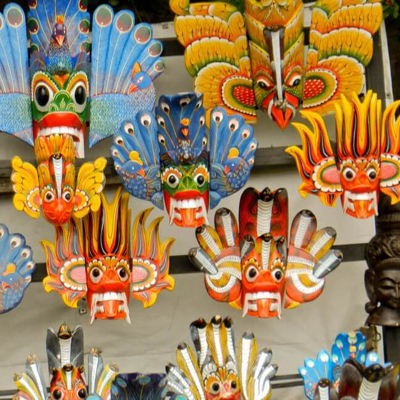WOODEN MASKS

If you have ever visited this meticulous country formerly known as the pearl of the Indian ocean and more commonly known to the world as Sri Lanka, you are bound to take a road trip through the south western coastal belt and in doing so you are sure to pass through a more unique uncommon town full of rugged devil faces all staring at you with brim. No, I am not referring to people I am merely articulating to the wonderous town of Ambalangoda which is well known for it’s mask making industry.
Although the mask making industry is not something that originated from Sri Lanka it is set to believe that we have inherited these traditions of mask making that is followed by a keen act of devil dancing from the cities of Kerala and Malabar in India. But our Sri Lankan artisans have been able to incorporate more embellishing techniques and colors in the masks to make it their own heritage with an added touch of their own unique style.
Like anything ever made masks serve a purpose as well and were not just for show. Masks are mainly used for dramatic adaptations, dance performances and for various rituals that are mostly used to cure sicknesses and to cast away the devil who is believed to be the main causer of the illness. The mask represents the face of the demon that is used to cast away the devil. This is all done and performed according to ancient beliefs and conducted by ritualistic gurus.
According to old ancient folk tales sri lanka was ruled by a race of Raakshass or more commonly known as devils. Who’s king was ravana of the legend Ramayanaya. And this race was able to take various forms which is now manifested through the masks. There are different categories in mask making such as Raksha Masks, Sanni Masks and Kolam masks. The types of Raksha masks include the cobra mask, the mask of a bird and the mask of the demon of death. The Sanni mask is used mainly to treat illnesses and there are 18 types of Sanni masks currently in use. The Kolam mask is the type that is used mainly in dramas and two of the most popular Kolam masks are Jaysaya and Lenchina
Well, how these masks are made you ask? It is no sizzle process, in fact, the process takes days which requires a great deal of patience and skill. It is started off with the chopping of timber. A tree known as “Wel Kaduru” also known as “Diya Kaduru” to some rural areas is found mostly close to paddy fields and marshy lands. The process begins after the tree trunk is chopped into small logs or the size of the mask needed and is kept to dry in the sun to take the saps out. Then the complex work of carving and painting begins using specially designed tools.
People in our modern world have found many new ways to incorporate this old tradition into their modern homes. It is currently being used as a form of security from the devil by hanging it on the wall they hope to cast out any evil. There are many masks with different faces that represent a different meaning and people hang whichever they see fit or most suitable for their situation. The masks are also used as an ornament for antique displays in modern homes and hotels.
Be it for casting out evil or just simply for display and in doing so this tradition will continue to live on with its glory through the people of Sri Lanka.

